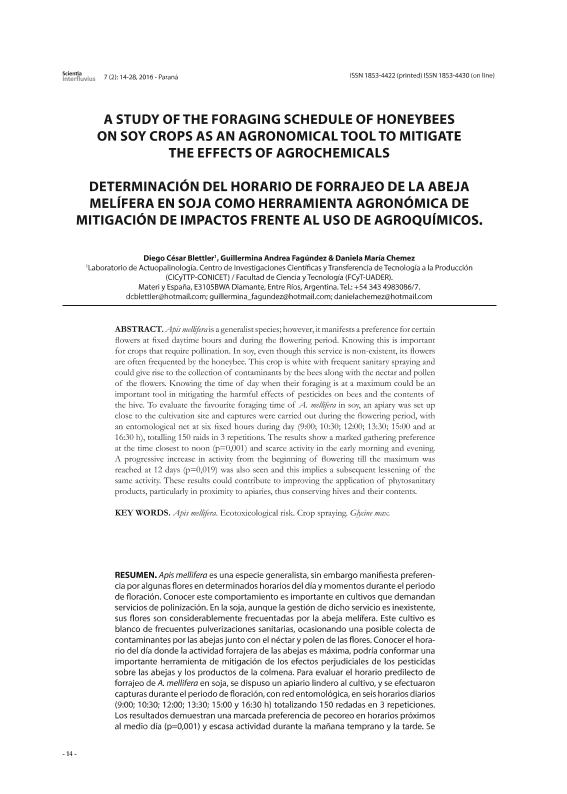Mostrar el registro sencillo del ítem
dc.contributor.author
Blettler, Diego César

dc.contributor.author
Fagundez, Guillermina Andrea

dc.contributor.author
Chemez, Daniela María

dc.date.available
2019-07-30T19:57:43Z
dc.date.issued
2016-12
dc.identifier.citation
Blettler, Diego César; Fagundez, Guillermina Andrea; Chemez, Daniela María; A study of the foraging schedule of honeybees on soy crops as an agronomical tool to mitigate the effects of agrochemicals; Universidad Autónoma de Entre Ríos; Scientia Interfluvius; 7; 2; 12-2016; 14-28
dc.identifier.issn
1853-4422
dc.identifier.uri
http://hdl.handle.net/11336/80621
dc.description.abstract
Apis mellifera is a generalist species; however, it manifests a preference for certain flowers at fixed daytime hours and during the flowering period. Knowing this is important for crops that require pollination. In soy, even though this service is non-existent, its flowers are often frequented by the honeybee. This crop is white with frequent sanitary spraying and could give rise to the collection of contaminants by the bees along with the nectar and pollen of the flowers. Knowing the time of day when their foraging is at a maximum could be an important tool in mitigating the harmful effects of pesticides on bees and the contents of the hive. To evaluate the favourite foraging time of A. mellifera in soy, an apiary was set up close to the cultivation site and captures were carried out during the flowering period, with an entomological net at six fixed hours during day (9:00; 10:30; 12:00; 13:30; 15:00 y 16:30 h), totalling 150 raids in 3 repetitions. The results show a marked gathering preference at the time closest to noon (p=0,001) and scarce activity in the early morning and evening. A progressive increase in activity from the beginning of flowering till the maximum was reached at 12 days (p=0,019) was also seen and this implies a subsequent lessening of the same activity. These results could contribute to improving the application of phytosanitary products, particularly in proximity to apiaries, thus conserving hives and their contents.
dc.format
application/pdf
dc.language.iso
eng
dc.publisher
Universidad Autónoma de Entre Ríos
dc.rights
info:eu-repo/semantics/openAccess
dc.rights.uri
https://creativecommons.org/licenses/by-nc-sa/2.5/ar/
dc.subject
Apis Mellifera
dc.subject
Ecotoxicological Risk
dc.subject
Crop Spraying
dc.subject
Glycine Max
dc.subject.classification
Otras Producción Animal y Lechería

dc.subject.classification
Producción Animal y Lechería

dc.subject.classification
CIENCIAS AGRÍCOLAS

dc.title
A study of the foraging schedule of honeybees on soy crops as an agronomical tool to mitigate the effects of agrochemicals
dc.title
Determinación del Horario de forrajeo de la abeja melífera en soja como herramienta agronómica de mitigación de impactos frente al uso de agroquímicos
dc.type
info:eu-repo/semantics/article
dc.type
info:ar-repo/semantics/artículo
dc.type
info:eu-repo/semantics/publishedVersion
dc.date.updated
2019-07-22T13:16:17Z
dc.identifier.eissn
1853-4430
dc.journal.volume
7
dc.journal.number
2
dc.journal.pagination
14-28
dc.journal.pais
Argentina

dc.journal.ciudad
Paraná
dc.description.fil
Fil: Blettler, Diego César. Universidad Autónoma de Entre Ríos; Argentina
dc.description.fil
Fil: Fagundez, Guillermina Andrea. Provincia de Entre Ríos. Centro de Investigaciones Científicas y Transferencia de Tecnología a la Producción. Universidad Autónoma de Entre Ríos. Centro de Investigaciones Científicas y Transferencia de Tecnología a la Producción. Consejo Nacional de Investigaciones Científicas y Técnicas. Centro Científico Tecnológico Conicet - Santa Fe. Centro de Investigaciones Científicas y Transferencia de Tecnología a la Producción; Argentina. Universidad Autónoma de Entre Ríos; Argentina
dc.description.fil
Fil: Chemez, Daniela María. Universidad Autónoma de Entre Ríos; Argentina
dc.journal.title
Scientia Interfluvius
dc.relation.alternativeid
info:eu-repo/semantics/altIdentifier/url/http://sif.uader.edu.ar/?page_id=28
Archivos asociados
